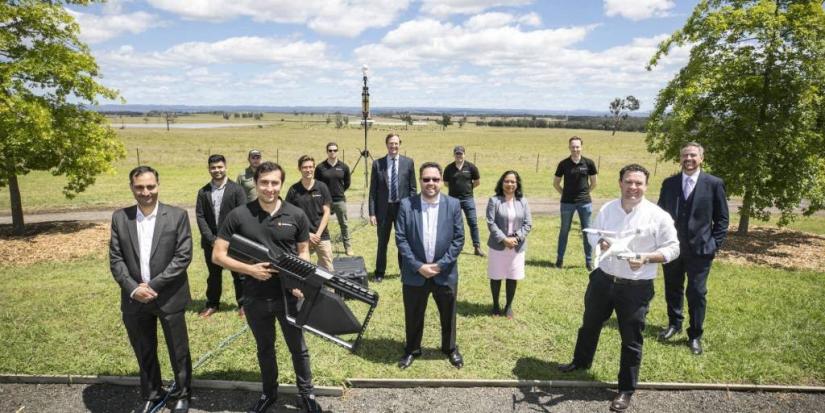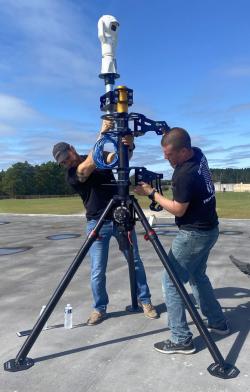There are drones that illegally deliver drugs and other contraband to prisoners and drones that carry biological weapons or explosives. There are also drones that can shut down airports, take photos in private places, and even spy on rival football teams.
All of these are now easier to detect and neutralise, thanks to a collaboration between UTS and Sydney-based company DroneShield that has developed world-leading technology.
In 2019, DroneShield approached UTS, knowing that Dr Nabin Sharma and the Intelligent Drone Lab team in the Australian Artificial Intelligence Institute had some of the world’s best expertise for deep-learning detection of objects such as drones.
Dr Sharma’s team developed systems that combines deep-learning neural networks with image-processing techniques, sensors and software, including the multiple award-winner SharkSpotter technology. They had won international competitions in detecting drones using camera technology.
Friend or foe?
“DroneShield already had a product, but they wanted to boost their accuracy,” Dr Sharma says. “They were using multiple sensors such as radio frequency detectors and radar, but didn’t have vision – something akin to a human eye."
"We needed to use our deep-learning neural networks to analyse a camera feed in real time and determine, ‘Is this drone carrying a payload that could be dangerous?’ We had the expertise and knew what was potentially going to work, and I have industry background and know how to get research translated into a commercial product."
Dr Sharma says that the requirements for the project were complex, and very different to SharkSpotter. It needed incredibly accurate performance in real time, and to be deployable in existing small, portable hardware, with limited space and power. “We ended up doing everything from scratch,” he says.
DroneShield’s Vision AI Team Leader, Guillaume Jounel, says about eight personnel from UTS and DroneShield worked together on the research project for less than a year.
DroneShield has already won several major industry awards:
- 2022 Commercialisation Champion Award from the Defence Industry Network
- Business and Industry Solution of the Year and Technology Platform Solution of the Year at the 2021 NSW iAwards from the Australian Information Industry Association
- 2021 Defence Innovator of the Year - Company at the Australian Defence Industry Awards
The technology has been so successful that DroneShield has expanded and the product is now offered by 120 partners around the world.
The biggest challenge was that we needed everything to be real-time. If it takes 10 seconds to detect a drone, it’s already gone.
Guillame Jounel, DroneShield
“There were many challenges, but both sides had a lot to offer,” Guillaume says. “I think the biggest challenge was that we needed everything to be real-time. If it takes 10 seconds to detect a drone, it’s already gone.”
Staying one step ahead
Guillaume says drone technology is changing rapidly and keeping ahead of organisations developing nefarious drones is vital.
“Threats evolve quickly so we have to keep looking at what’s being developed and adapt very quickly. It’s a very fast-paced environment. Since the project with UTS we have continued to develop the capabilities, and now we do night-time detections as well using thermal cameras,” he says.
Even with a low-cost camera, the system can detect and analyse mid-sized drones travelling at more than 60km/h from 1.5km away. The optic system can be used in restricted environments, such as near airports, where radar can’t be used.
The camera can automatically pinpoint the location of the drone, assess the threat level, trigger alerts and capture video recordings. DroneShield’s counter measures can then be applied as necessary, from jamming to destruction.
“Radar only detects anything moving – it could be birds or anything flying,” Guillaume says. “But cameras give you that visual confirmation. The optics combined with the rest of our system provides a complete solution.”
Guillaume recommends any industry needing AI technology in the future should consider working with a university such as UTS.
Dr Sharma says universities can make great research partners for industry because they have a lot of expertise in different areas to solve a problem. UTS in particular has a focus on doing practical, applicable research.
“I don’t find much benefit in having research that is not used by anyone,” he says. “It should have some sort of a commercial outcome or benefit to the community.”
Research team
-
Australian Artificial Intelligence Institute
-
Australian Artificial Intelligence Institute
-
Guillame JounelDroneShield






